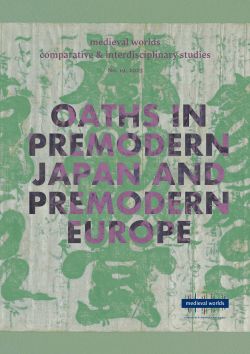 |
 |
Walter POHL – Andre GINGRICH (Eds.) - Philippe Buc - Thomas D. Conlan (Guest Eds.)
medieval worlds • no. 19 • 2023
Horikawa Yasufumi
S. 86 - 118 doi: 10.1553/medievalworlds_no19_2023s86
Verlag der Österreichischen Akademie der Wissenschaften doi: 10.1553/medievalworlds_no19_2023s86
Abstract:
This article introduces five oaths (kishōmon) from sixteenth-century Japan, currently held by the East Asian Library, Princeton University, United States. Each of these documents can be identified as one half of an oath passed down to the Saji family, a local warrior (samurai) family based in Kōga district, Ōmi province, central Japan (the other half was separated). Local warriors of Kōga are well known for their multi-layered networks and organizations called collectives (sō), which served as mediators in local disputes. Combining these Princeton oaths (we shall keep to this English term for the Japanese kishōmon) with other documents that survived in the Saji’s hereditary archive, this article discusses their function. We have here a case study of Kōga that reconstructs local disputes and mediation by local warriors and sheds light on their collective organizations. This article also explores how medieval people envisioned divine punishments for breaking promises to deities. The diary of Yoshida Kanemi, a Shintō priest in Kyoto, contains valuable information: people of Kōga and its surrounding areas often visited Kanemi and asked him for prayers to cancel the oaths they had written. Kanemi’s diary shows that the people of Kōga on the one hand did indeed fear divine punishments but, on the other, tried to avoid them by drawing on new practices offered by Yoshida Shintō. After the destruction of the Kōga gunchū sō, a district-wide collective of local warriors of Kōga, in 1585, the Saji and other local warriors were banished from Kōga. They later returned to their homeland but lost their warrior privileges in the region. In this process, the Saji lost some of their inherited documents, including those currently held by Princeton University. Thus, the Princeton oaths not only tell us how medieval oaths functioned in Warring States Japan but also describe the hardship one local warrior family experienced in the socio-political transition from the medieval to the early modern (Tokugawa) period.
Medieval Japan, Warring States period, oath, kishōmon, Kōga district collective (Kōga gunchū sō), Yoshida Shintō Published Online:
2023/11/30 10:17:29 Object Identifier:
0xc1aa5576 0x003ea4fd
Rights:https://creativecommons.org/licenses/by-nc-nd/4.0/
"medieval worlds" provides a forum for comparative, interdisciplinary and transcultural studies of the Middle Ages. Its aim is to overcome disciplinary boundaries, regional limits and national research traditions in Medieval Studies, to open up new spaces for discussion, and to help developing global perspectives. We focus on the period from c. 400 to 1500 CE but do not stick to rigid periodization.
medieval worlds is open to submissions of broadly comparative studies and matters of global interest, whether in single articles, companion papers, smaller clusters, or special issues on a subject of global/comparative history. We particularly invite studies of wide-ranging connectivity or comparison between different world regions.
Apart from research articles, medieval worlds publishes ongoing debates and project and conference reports on comparative medieval research.
In this volume, guest editors Philippe Buc and Thomas D. Conlan use oaths as the pivotal point for their comparative thematic section. Focusing on the differences and similarities between Japanese and European oath-taking and oath-breaking practices during the medieval period, on terminology and on chronology, Philippe Buc provides an introduction that contextualises the studies in this collection. For Japan, Yoshikawa S. and T.D. Conlan give insights into the development of the written oath (kishōmon) from its predecessors and origins in the third to sixth centuries to the sixteenth century, M. Gilbert and Horikawa Y. provide case studies of kishōmon in the heyday of its use. For Western Europe, S. Esders outlines the development of oaths from Late Antiquity to the tenth century under Christian doctrinal influence. In three case studies, H. Reimitz, H. Débax and O. Richard illustrate the use of oaths in the Early, High and Late Middle Ages.
In our individual articles section, E. Worrall, R. Kramer and T. Grant offer a new edition and commented translation of an Icelandic fragment of the Nikuláss saga erkibiskups, the Saga of Bishop Nicholas.
|




 Home
Home Print
Print
 References
References
 Share
Share
